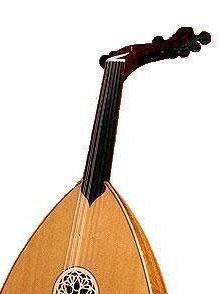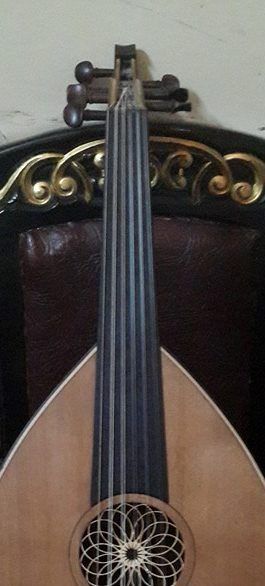Hasan
Oud Addict
  
Posts: 35
Registered: 11-17-2014
Member Is Offline
|
|
extended (long) fingerboard? why?
from what i see, nowadays most ouds come with extended long fingerboards.
i asked an oud makers : does the long piece of wood glued to the neck and face help keeping the neck straight? answer was: no, there are other
factors.
what do you think is a good reason for having an extended board?
|
|
|
spyblaster
Oud Junkie
    
Posts: 285
Registered: 2-17-2010
Location: Iran - Karaj
Member Is Offline
|
|
can you post a photo of what you mean?
The Oud is my life, n my life is the Oud
|
|
|
hussamd
Oud Junkie
    
Posts: 117
Registered: 12-18-2013
Location: Bartlett, IL
Member Is Offline
|
|
You would think it helps stability. It looks better to me than just stopping at the bowl, unless you have some ornamentation to blend it in.
|
|
|
SamirCanada
Moderator
     
Posts: 3404
Registered: 6-4-2004
Member Is Offline
|
|
its for fingering in the deep positions. makes a cleaner sound and doesnt stain like fingering on the spruce soundboard.
@samiroud Instagram
samiroudmaker@gmail.com
|
|
|
Hasan
Oud Addict
  
Posts: 35
Registered: 11-17-2014
Member Is Offline
|
|
short fingerboard

long fingerboard

|
|
|
Hasan
Oud Addict
  
Posts: 35
Registered: 11-17-2014
Member Is Offline
|
|
husam.. i think i prefer the looks of long boards too but i've seen very beautiful ouds with short fingerboards ..matter of taste.
when playing with a short fingerboard to me the oud seems "natural" and nicely blended.. just a feel
samir.. that could be a good reason
interesting, yet you see players like yordal tokan and hakan play ouds with short fingerboard and both play deep positions:
video
hakan 6 octave
|
|
|
hussamd
Oud Junkie
    
Posts: 117
Registered: 12-18-2013
Location: Bartlett, IL
Member Is Offline
|
|
I prefer the look of the long fingerboard. I wonder if others have the same observation you brought up Hasan. The longer fingerboard will change the
area available for the face to vibrate - mathematically speaking, which could change the sound.
Any oud makers to comment on this?
Hussam
|
|
|
SamirCanada
Moderator
     
Posts: 3404
Registered: 6-4-2004
Member Is Offline
|
|
No it doesn't change the sound of the oud much. There is little vibration happening there anyways as it is a dead area of the soundboard. There are
some advantages to both ways. however, in my opinion its also easier to make a long finger board than to inlay a decorative piece "beard" at the end
of the fingerboard. Maybe other makers disagree but its my personal experience.
I think the long fingerboard started appearing with the introduction of the floating bridge oud. The bridge on floating bridge ouds raises the string
height considerably compared to the fixed bridge, a long fingerboard (one that gets thicker and higher as you approach the sound hole) allows to
maintain a low action throughout the high fingering positions. Mind you very few players would exploit that fully, mainly those who play technical
pieces like Jamil Bashir's caprice etc...Also, it borrows from the violin, mandolin and classical guitar the idea of fingerboard extending over the
face.
Ecstatically, its nice I agree but I can see the beauty in both like a classic Manol or Nahat.
You also avoid staining the spruce with the finger oils. With that said, many accomplished players like Yurdal and other Turkish masters don't seem to
care though that there are stains, they are almost proud of it as in to show the instrument has been played and has character.
One common disadvantage however comes from gluing 2 different woods (ebony glued to spruce ex..) on top of each other which shrink and expand at much
different rates. This often causes cracks on the face along the fingerboard. ITs not very dangerous to the instrument but its unsightly.
@samiroud Instagram
samiroudmaker@gmail.com
|
|
|
jdowning
Oud Junkie
    
Posts: 3485
Registered: 8-2-2006
Location: Ontario, Canada
Member Is Offline
Mood: No Mood
|
|
There are two kinds of extended fingerboards on ouds - extensions that are inlaid into the sound board and those that are fingerboards of one piece
glued over the sound board.
Samir suggests that the one piece extended fingerboard appeared with floating bridge ouds (so dating to the 1950's?).
However, the inlaid type of extension pre-dates that time and can be found for example on some of the Nahat ouds dated prior to 1934. That
exceptionally beautiful oud - the 1917 Abdo Nahat once owned by the late Hamza El Din is another example. A problem is that a number of early ouds
appear to have been 'restored' in recent times with replacement one piece fingerboards glued over the sound board - contrary to their original
condition. Presumably such a modification requires raising the bridge height which likely does affect sound production.
The inlaid extensions are cut into the sound board to full sound board thickness so create a sound board discontinuity. Samir is probably correct in
assuming that this feature has little effect on sound production but no comparative tests have been done to confirm this as far as I know.
For information, the attached images are of an old Egyptian oud that I own that has an inlaid finger board extension - cut into the sound board to a
full depth of 1.5 mm. It is reinforced underneath with glued paper and a single brace positioned mid way between the sound hole and neck block.
[file]33795[/file] [file]33797[/file]
|
|
|
Dr. Oud
Oud Junkie
    
Posts: 1370
Registered: 12-18-2002
Location: Sacramento, CA, USA
Member Is Offline
Mood: better than before
|
|
Adding a fingerboard on top of the soundboard can correct the string height/action on an oud that has warped or bent over the years of string tension.
The floating bridge requires a higher string height in order to increase string pressure on the face. Without the added height of the extended
fingerboard the neck would have to be set at an angle that would not allow fingering above the neck joint. The tail of the floating bridge is also
lowered to allow higher tension. The original Bashir oud made by Fadel Hussein in 1956 actually had a bent face similar to the round back mandolin.
Another benefit of a one piece fingerboard on top is that the neck joint is reinforced by the solid fingerboard.
|
|
|
Hasan
Oud Addict
  
Posts: 35
Registered: 11-17-2014
Member Is Offline
|
|
yesterday i asked another oud maker ( total two now: Hussain Sabsaby from Syria and Ibrahim Ada from Turky ) whether the neck and joing can benefit
from an extended long piece of fingerboard to stay straight. both said there's no effect and that it's all about the work inside the neck not
outside.
Dr. Oud suggests that one piece fingerboard on top reinforces the neck joint. that makes more sense i think. a flat piece of hard wood like ebony must
help keeping things straight.
the scenario SamerCanada mentioned about the cracks on the face along the fingerboard must be considered although i dont know how likely it is to
happen. searching this forum I read a post about 2 ouds developing cracks on the face along the fingerboard.
if discussed more, can this issue end up with a conclusion that one fingerboard design is better or more durable or convenient than the other?
thanks everyone
|
|
|
jdowning
Oud Junkie
    
Posts: 3485
Registered: 8-2-2006
Location: Ontario, Canada
Member Is Offline
Mood: No Mood
|
|
Oud and lute fingerboards are quite thin so the effect of any reinforcement provided by the fingerboard overlapping the neck joint would be minimal
and would certainly not compensate for a poorly made neck joint - which is the point the two luthiers that you spoke to are making.
A one piece fingerboard will also complicate any neck resetting work.
Having said that it was standard practice among 16th C (and later) lute makers to either allow the fingerboard to overlap the neck joint and onto the
neck block (early 16th C) or, more usually, to allow the sound board to overlap the neck joint so providing a smooth transition over the neck
joint.
For information, the attached images of two of my lutes - copies I have made of surviving 16th C lutes illustrates the two alternatives. Both lutes
require a lutenist to stop strings above the final fret position (7th or 8th) onto the sound board surface In the case where the fingerboard overlaps
the neck joint this would provide a hard surface for the unfretted 8th position. String stops higher than that would be on the unfretted sound board
surface.
|
|
|
fernandraynaud
Oud Junkie
    
Posts: 1865
Registered: 7-25-2009
Location: San Francisco, California
Member Is Offline
Mood: m'Oudy
|
|
Beautiful instruments, @jdowning!
|
|
|
bulerias1981
Oud Junkie
    
Posts: 763
Registered: 4-26-2009
Location: Beacon, NY
Member Is Offline
Mood: John Vergara Luthier Lord of the Strings instrument making and repair
|
|
Like Dr. Oud, I also believe the extended fingerboard provides some strength to the neck joint AND the pegbox. I can't see how joining a piece of wood
on top of the pivot point (neck joint) that covers both the neck and soundboard wouldn't provide a bit more extra strength. I can't say how much, but
in my estimation, anywhere from 5-15% stronger. (which is a step in the right direction) Maybe a little more depending on the thickness of the
fingerboard. If its really thin in that area, then 0-5%! Also, issues with the action can be worked out by installing a new fingerboard just as Dr.
Oud says.
I've reinforced many pegboxes that were loose. You can check how strong it is by bending it gently up and down. If the joint is poor, and the wood
above the notch on the neck is thin, the pegbox will certainly move up and down. This is bad, because with tension the pegbox may be pulled up, and
this will actually raise the action in some cases significantly. A fingerboard on top of that surface will strengthen the pegbox and prevent this
unwanted pivot. (it's important to reinforce the joint first of course!)
|
|
|